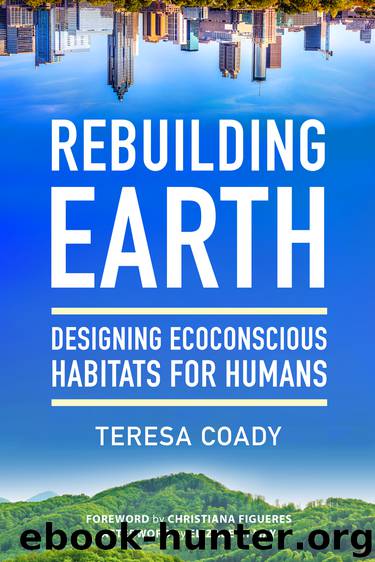Rebuilding Earth by Teresa Coady

Author:Teresa Coady [Coady, Teresa]
Language: eng
Format: epub, azw3
ISBN: 9781623174323
Publisher: North Atlantic Books
Published: 2020-03-05T00:00:00+00:00
Chapter 8
Earth: Earth Energy and Materials
In most traditional building practices, all materials were selected for their “energy” along with their other properties. For example, the Chinese Feng Shui system recognizes glass as the building material metaphor for water, which is linked to the flow of wealth in this time-honored system. I have designed many international bank branches and the headquarters for a major bank servicing Chinese customers. I was required to consider the energy of each element I specified.
When my work was later reviewed by a Feng Shui master, I discovered that what I had intuited as a good, balanced design was also aligned with the natural principles of Feng Shui. As a result of this innate ability to sense material energy, I became a popular designer for the bank. Even today, every branch design is still reviewed in the same manner for the essential use of glass, and for the harmonious balance of stone, wood, metal, and fire energies, to ensure the continuing prosperity of the bank.
This is an unusual story for a modern-day architect to be able to tell.
Our use of earth materials is no longer sensitive. It is also out of control. Since 1990, it seems that humans have extracted more resources from the planet than we have in all of the rest of our human history. The rate of material extraction, and waste, is increasing much faster than population growth, which is already exponential. On a per capita use of materials, it took thirty years to go from 6.4 tons in 1970 to 7.9 tons in 2000, but only ten years to reach 10.1 tons per capita in 2010, and, unless we do something about it, extraction rates will reach nearly 20 tons per capita by 2050.
Most of these extracted resources have been directed toward the construction industry and comprise various forms of stone and ores providing us with glass, concrete, and steel. While food and clothing material (biomass) extraction rates remained relatively flat, the average extraction rates for fossil fuels, metal ores, and nonmetallic minerals grew by 2.9%, 3.5%, and 5.3% respectively every year between 2000 and 2010. At this rate, we will need over 180 billion tons for over nine billion people by 2050.
Twenty tons per person, per year, extracted from the earth—with 70% of it returned to a landfill annually. This is where things are going if we do nothing.
So, we must do something because the earth does not have unlimited resources. What are we taking out, and why? Let’s look at where we use ores and nonmetallic minerals in construction just to get a better understanding of the whole picture.
Let’s start with glass. Glass is about 75% silicon dioxide, or sand, in the form of quartz. This quartz is the second most common material on the earth’s crust (after feldspar) because it is not water soluble and is hard enough to resist weathering away; the white powdery sand found on coral beaches is calcium carbonate and is not used for glassmaking. Glass
Download
This site does not store any files on its server. We only index and link to content provided by other sites. Please contact the content providers to delete copyright contents if any and email us, we'll remove relevant links or contents immediately.
Kathy Andrews Collection by Kathy Andrews(10519)
The remains of the day by Kazuo Ishiguro(7551)
Spare by Prince Harry The Duke of Sussex(4195)
Paper Towns by Green John(4169)
The Body: A Guide for Occupants by Bill Bryson(3800)
Be in a Treehouse by Pete Nelson(3212)
Harry Potter and the Goblet Of Fire by J.K. Rowling(3043)
Goodbye Paradise(2962)
Never by Ken Follett(2880)
Into Thin Air by Jon Krakauer(2701)
The Remains of the Day by Kazuo Ishiguro(2617)
The Genius of Japanese Carpentry by Azby Brown(2609)
The Cellar by Natasha Preston(2595)
Drawing Shortcuts: Developing Quick Drawing Skills Using Today's Technology by Leggitt Jim(2532)
120 Days of Sodom by Marquis de Sade(2436)
Architecture 101 by Nicole Bridge(2350)
The Man Who Died Twice by Richard Osman(2298)
Machine Learning at Scale with H2O by Gregory Keys | David Whiting(2290)
Fairy Tale by Stephen King(2069)
